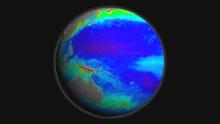
Global Warming is Reducing Ocean Life, Increasing Atmospheric Carbon Dioxide, Say Scientists
Alarming new satellite data show that the warming of the world's oceans is reducing ocean life while contributing to increased global warming.
The ocean's food chain is based upon the growth of billions upon billions of microscopic plants. New satellite data show that ocean warming is reducing these plants –– thus imperiling ocean fisheries and marine life, according to an article in the Nov. 7 issue of the scientific journal Nature.
"We show on a global scale that the growth of these plants, called phytoplankton, is strongly tied to changes in the warming of the ocean," said David Siegel, co-author and professor of marine science in the Department of Geography at the University of California, Santa Barbara. Siegel is also director of the Institute for Computational Earth System Science (ICESS).
"Phytoplankton grow faster in a cool ocean and slower in a warm one," said Siegel. "The scary part is that the oceans are warming now -- probably caused by our emissions of greenhouse gases, like carbon dioxide."
These microscopic plants are predicted to grow even slower in the warmer oceans of the future. This in turn will reduce the food available to fish and other organisms, including marine birds and mammals, which are supported by the ocean's food chain. Phytoplankton are responsible for about the same amount of photosynthesis each year as all the plants on land combined.
Another disturbing result of reduced phytoplankton is that our atmosphere depends on the consumption of atmospheric carbon dioxide by these plants. Reduced phytoplankton means less carbon dioxide is taken up by the ocean, which could speed global warming, contributing to a vicious cycle of increased warming.
"Rising levels of carbon dioxide in the atmosphere play a big part in global warming," said lead author Michael Behrenfeld of Oregon State University. "This study shows that as the climate warms, phytoplankton growth rates go down and along with them the amount of carbon dioxide these ocean plants consume. That allows carbon dioxide to accumulate more rapidly in the atmosphere, which would produce more warming."
The findings are from a NASA-funded analysis of data from the Sea-viewing Wide Field-of-view Sensor (SeaWiFS) instrument on the OrbView-2 spacecraft, launched in 1997. The uninterrupted nine-year record shows in great detail the ups and downs of marine biological activity or productivity from month to month and year to year. Captured at the start of this data record was a major, rapid rebound in ocean biological activity after a major El Niño event. El Niño and La Niña are major warming or cooling events, respectively, that occur approximately every three to seven years in the eastern Pacific Ocean and are known to change weather patterns around the world.
Scientists made their discovery by comparing the SeaWiFS record of the rise and fall of global ocean plant life to different measures of recent global climate change. The climate records included several factors that directly affect ocean conditions, such as changes in sea surface temperature and surface winds. The results support computer model predictions of what could happen to the world's oceans as the result of prolonged future climate warming.
"When we compared changes in phytoplankton activity with simultaneous changes in climate conditions, the agreement between the two records was simply astonishing," Behrenfeld said.
Ocean plant growth increased from 1997 to 1999 as the climate cooled during one of the strongest El Niño to La Niña transitions on record. Since 1999, the climate has been in a period of warming that has seen the health of ocean plants diminish.
The new study also explains why a change in climate produces this effect on ocean plant life. When the climate warms, the temperature of the upper ocean also increases, making it "lighter" than the denser cold water beneath it. This results in a layering or "stratification" of ocean waters that creates an effective barrier between the surface layer and the nutrients below, cutting off phytoplankton's food supply. The scientists confirmed this effect by comparing records of ocean surface water density with the SeaWiFS biological data.
† Scientists now have nearly a decade's worth of data showing the cycle of plant life in the Earth's oceans. From space, the "ocean color" satellites measure the ocean's biology as plant productivity. In this visualization, high plant productivity is represented in green, while areas of low productivity remain blue. Data were collected by the Sea-viewing Wide Field-of-view Sensor (SeaWiFS). (+ High Resolution Source) Credit: NASA/GeoEye
For more illustrations, visit this NASA Web page.
Related Links



